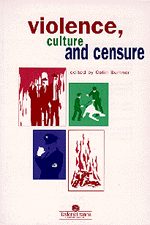

![]()
Violence, Culture and CensureColin SumnerTaylor & Francis: Basingstoke 1996 0 7484 0555 0 (pb) ·13.95 viii + 221 pp.
| The Web of Violence: From Interpersonal to GlobalJennifer Turpin and Lester R. KurtzUniversity of Illinois Press: Champaign, IL. 1997 0 252 06561 1 (pb) US$15.95 248 pp.
|

Certainly it is the case that the use of violence to achieve political and perhaps even personal ends has intensified in the later parts of the twentieth century. Sumners' collection, combining perspectives from sociology and cultural studies, is a valuable addition to a recent literature which has built up our understanding of the phenomenon of violence. It is good in its call for a new approach to examining the ethics of force and the ways in which violence and 'unreason' are anlaysed within the social sciences and the humanities. However, when set alongside other literatures which also take interdisciplinary approaches (for example in peace research and conflict theory), some of the limitations of the book are manifested, particularly it seems to me around the question of how to respond to violence. In all situations of violence there are individuals and groups determined to oppose its destructive dynamics. Cultures of peace can be counter-posed to cultures of violence. Thus, conceptions of power and dominance taken from Foucault, Gramsci and Habermas suggest respectively anti-hegemonic, counter-hegemonic and post-hegemonic peace-building projects. Similarly we can point to the importance of transformative counter-discourses in challenging the dominance of public space by exclusionist hegemonic discourses which legitimate violence and war.
In The Web of Violence Jennifer Turpin and Lester Kurtz point to the same paradox about violence noted by Sumner: that the use of violence is considered taboo, yet while it is universally abhorred it is also used to impose power and social control in all settings from the interpersonal to the global. Theorising about violence is important in itself, but also because of its implications for social policy (how to change violent behaviours). The objective of the book is to explore the links between different dimensions of violence, from the interpersonal to the global, in an effort to identify the 'social mechanisms' that link interpersonal with global levels of analysis. They postulate that there is a micro-macro link and dynamic across a broad spectrum of conflict types. If there are such links and dynamics, then the phenomenon of violence, they assert, must be responded to comprehensively and holistically. The book then is an early exploration into the development of such an interdisciplinary and integrative approach. The introduction by the editors, Turpin and Kurtz, makes the case for linkage or similarities in the comparative analysis of violence across personal, social, and political-international dimensions. In this sense they are following research pioneered by the conflict and peace research community, who have been making similar claims for a number of years (as for example in the work of Burton, Mitchell, Azar, Galtung, Curle and others). Their introduction provides a brief but excellent critical summary of the literature on theorising violence using perspectives from biological and physiological theories; from the work of historians, psychologists and social psychologists, sociologists and anthropologists, and political scientists. From the well established traditions of work in these fields Turpin and Kurtz correctly call for more interdisciplinarity where conventional discipline frameworks can be transcended and a more comprehensive understanding gained, particularly of micro-macro links and similarities. They suggest that most progress in this interdisciplinary approach has been made in the fields of critical criminology, gender studies, peace and conflict studies, and public health analysis. The contributions to this book illustrate some of the work from these approaches. Lifton examines the psychological phenomenon of 'doubling'which enabled individuals to commit the kind of violence that occurred in Auschwitz: Ellison and Bartkowski show how the legitimation of corporal punishment in conservative protestant cultural traditions in the US to maintain family discipline may legitimise the use of violence in national and international settings. Other studies follow which then attempt to demonstrate in various ways and in a variety of contexts the means by which frameworks and discourses which legitimise violence are constructed (thus Chu on revolutionary rhetoric in China; Smith on Civil Society and Violence; Elias on a Culture of Violent Solutions; Brock-Utne on perspectives from peace and development research; Eisler on human rights and violence; and Galtung on the cultural programmes or codes of the major world belief systems or 'cosmologies'). Given this scope, the objectives of the book are indeed addressed in seeking to demonstrate that violence is 'a web of causal connections between personal-level and global-level structures, processes and behaviors'. What follows from this is a prescriptive or normative aspiration that ways out of this web may be found in a paradigm of research and action around common security and non-violent conflict resolution. This is no doubt a laudable aspiration which will find much support. However the gap between theory and reality remains a wide one, and researchers have some way to go before we reach the level of synthesis and integration of research findings called for by Turpin, Kurtz and others. We are some way away from providing integrated models, let alone comprehensive theories, of violence and violent conflict. One promising approach has been somewhat neglected in this collection, which is that provided by Edward Azar in his work on protracted social conflict, integrating as it does levels of analysis from psychology, anthropology and history, political economy, and international relations. The entry of work of this kind into the project of researching the 'dark side' of unreason and the dynamics of violence will strengthen the interdisciplinarity for which Turpin and Kurtz have argued.
Tom Woodhouse
University of Bradford